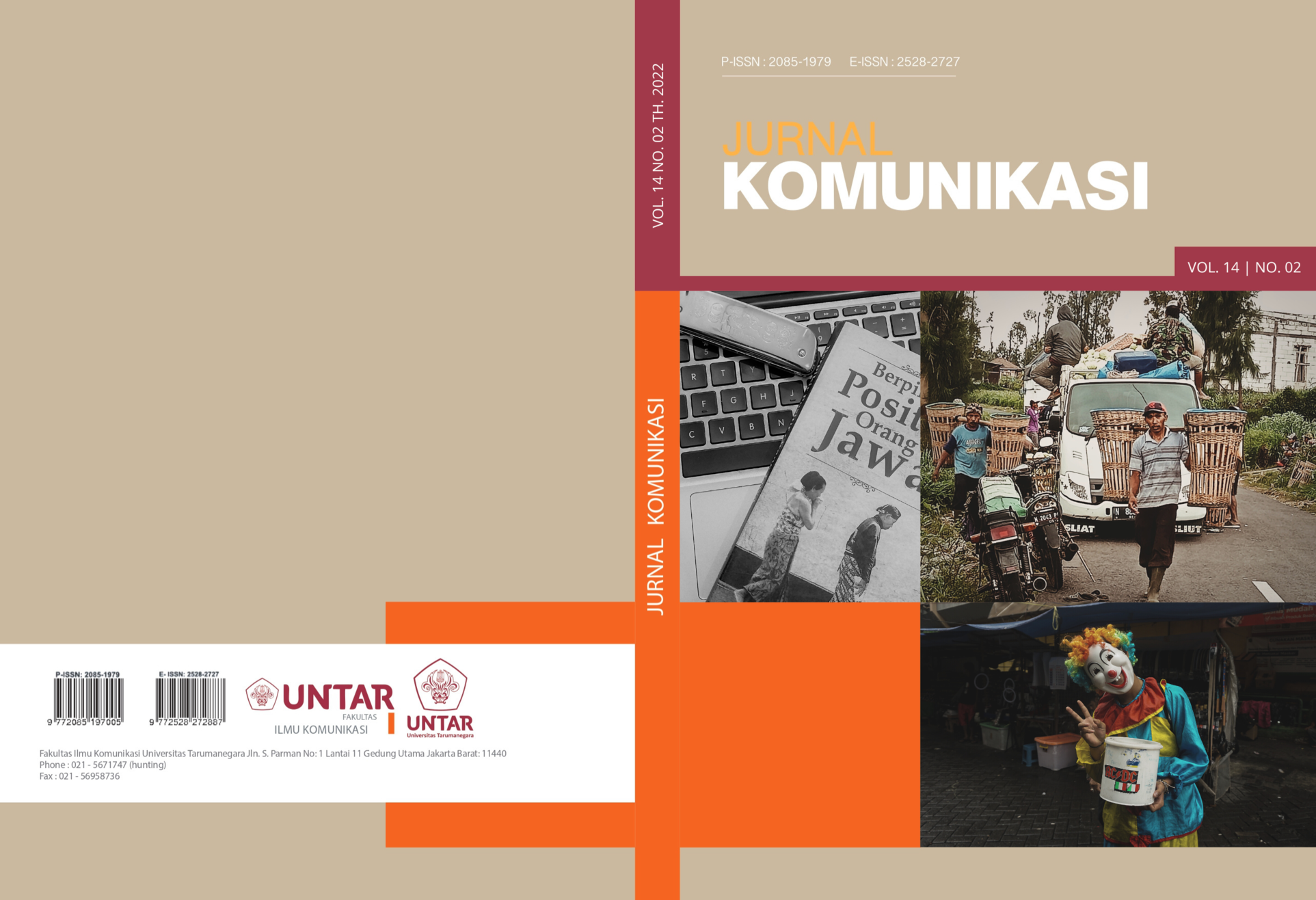Communication Network Analysis K-Pop Fans Through the WhatsApp Group Application
Main Article Content
Abstract
Korea Pop (K-Pop) is a music industry originating in South Korea. Its existence is currently one of the largest music industries in the world. Talking about K-Pop is inseparable from the reality of its fans. The presence of passionate fans makes K-Pop even more popular. Fans have various ways to worship the idols they like, one of which is a shipper. Activities, issues, or rumors concerning their idols are always discussed by shippers through discussion rooms, such as the WhatsApp Group, to exchange opinions or equalize opinions. This study aims to find out what the mapping of the communication network structure looks like in a Jenlisa Universe WhatsApp Group. Jenlisa Universe is a shipper community that pairs Blackpink members Jennie and Lisa, known as Jenlisa, in a relationship. Shippers are K-Pop fans who pair their idols with other idols in a pairing relationship, which can be romantic, romantic, friendship, family, and emotional. They always connect the activities of each idol as if they have a relationship with one another. Currently, Jenlisa's shipper is included in the top 5 shippers worldwide. This is why Jenlisa's shipper was chosen as the subject of this study. The theory needed is an opinion leader, namely a figure or leader who influences a community. The approach in this study is descriptive quantitative. The method used is Communication Network Analysis with the Chat Stats WhatsApp Statistics application, Ucinet, and interviews conducted with participants in the group. The results of this study show that Jenlisa Universe, as a WhatsApp Fanbase Group, has 13 famous actors who act as opinion leaders who serve as discussion guides for rumors, cases, or Jenlisa activities in a WhatsApp Group network.
Article Details

This work is licensed under a Creative Commons Attribution-ShareAlike 4.0 International License.
This work is licensed under a Jurnal Komunikasi Creative Commons Attribution-ShareAlike 4.0 International License.References
Akdevelioglu, D., & Kara, S. (2020). An international investigation of opinion leadership and social media. Journal of Research in Interactive Marketing, 14(1), 71–88. https://doi.org/10.1108/JRIM-11-2018-0155
Brown, S., Chen, L., & O’Donnell, E. (2017). Organizational opinion leader charisma, rolemodeling, and relationships. International Journal of Organizational Analysis, 25(1), 80–102. https://doi.org/10.1108/IJOA-10-2015-0924
Bungin, B. (2020). Post-Qualitative Social Research Methods Kuantitatif-Kualitatif-Mixed Methods Positivism-Postpositivism-Phenomenology-Postmodern Filsafat, Paradigma, Teori, Metode dan Laporan. Kencana.
Bursztyn, V. S., & Birnbaum, L. (2019). Thousands of small, constant rallies. Proceedings of the 2019 IEEE/ACM International Conference on Advances in Social Networks Analysis and Mining, 484–488. https://doi.org/10.1145/3341161.3342905
Castells, M. (2010). The Rise of the Network Society: With a New Preface, Volume I: Second Edition With a New Preface. https://doi.org/10.1002/9781444319514
Dixon Natalie. (2018). Stranger-ness and Belonging in a Neighbourhood WhatsApp Group. Open Cultural Studies, 7(1), 493–503. https://doi.org/https://doi.org/10.1515/culture-2017-0046
Eriyanto. (2014). Analisis Jaringan Komunikasi Strategi Baru dalam Penelitian Ilmu Komunikasi dan Ilmu Sosial Lainnya. Kencana.
Gerrard, Y. (2021). Groupies, Fangirls and Shippers: The Endurance of a Gender Stereotype. Https://Doi.Org/10.1177/00027642211042284, 66(8), 1044–1059. https://doi.org/10.1177/00027642211042284
Hapsari, D. R. (2016). PERAN JARINGAN KOMUNIKASI DALAM GERAKAN SOSIAL UNTUK PELESTARIAN LINGKUNGAN HIDUP. Jurnal Komunikasi Ikatan Sarjana Komunikasi Indonesia, 1(1), 25–36. https://doi.org/10.25008/JKISKI.V1I1.33
Kasali Rhenald. (2019). MO: Semua Dunia Baru yang Membuat Banyak Orang Gagal Paham. Mizan.
kingchoice. (2022). The 100 Most Favorite KPOP Ship Couples 2022. Www.Kingchoice.Me. https://kingchoice.me/the-100-most-favorite-kpop-ship-couples-2022/
Kusumo, R. A. B., & Charina, A. (2021). Analisis Jaringan Komunikasi pada Agribisnis Sayuran Organik di Kabupaten Bandung Barat. Jurnal Penyuluhan, 17(2), 206–217. https://doi.org/10.25015/17202132788
McQuail Denis. (2011). Teori Komunikasi Massa Mc Quail. Salemba Humanika.
Otmazgin, N., & Lyan, I. (2014). Hallyu across the Desert: K-pop Fandom in Israel and Palestine. Cross-Currents: East Asian History and Culture Review, 3(3), 32–55. https://doi.org/10.1353/ach.2014.0008
Paramita, S., & Irena, L. (2020). Retorika Digital dan Social Network Analysis Generasi Milenial Tionghoa melalui Youtube. Jurnal Komunikasi, 12(1), 137. https://doi.org/10.24912/jk.v12i1.7558
Susanto, E. H. (2017). MEDIA SOSIAL SEBAGAI PENDUKUNG JARINGAN KOMUNIKASI POLITIK. Jurnal ASPIKOM, 3(3), 379–398. https://doi.org/10.24329/ASPIKOM.V3I3.123
Taleb Nassim Nicholas. (2020). Buku The Black Swan: : Rahasia Terjadinya Peristiwa-Peristiwa Langka yang Tak Terduga. PT Gramedia Pustaka Utama.
Utami, L. S. S., & Winduwati, S. (2020). Fandom and Voluntary “ARMY”: Case Study on BTS Fans in Indonesia. Proceedings of the 2nd Tarumanagara International Conference on the Applications of Social Sciences and Humanities (TICASH 2020). https://doi.org/10.2991/assehr.k.201209.105
Yuanita, D. (2021). Peran key opinion leader dalam strategi public relations pada komunikasi krisis perusahaan. PRofesi Humas Jurnal Ilmiah Ilmu Hubungan Masyarakat, 6(1), 23. https://doi.org/10.24198/prh.v6i1.29693
Zahrotustianah. (2020). Heboh Foto “Dispatch” Chanyeol EXO dan Rose BLACKPINK, Cek 5 Faktanya. https://www.idntimes.com/hype/entertainment/zahro-1/heboh-foto-dispatch-chanyeol-exo-dan-rose-blackpink-cek-5-faktanya
Zhao, Y., Kou, G., Peng, Y., & Chen, Y. (2018). Understanding influence power of opinion leaders in e-commerce networks: An opinion dynamics theory perspective. Information Sciences, 426, 131–147. https://doi.org/10.1016/j.ins.2017.10.031



